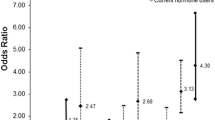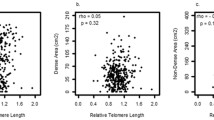Abstract
Mammographic density (MD), a strong marker of breast cancer risk, is influenced by genetic, environmental, and hormonal factors. Cadmium, a persistent and widespread environmental pollutant, has been associated with risk of breast cancer, and laboratory evidence suggests cadmium is a carcinogen in the breast. We investigated the hypothesis that cadmium exposure is associated with higher MD. In a cross-sectional study of MD and urinary cadmium concentration, percentage MD (MD%) and Breast Imaging-Reporting and Data Systems (BI-RADS®) density category were determined from screening mammograms of 190 premenopausal women ages 40–45 years. Women completed a health questionnaire, and the cadmium content of spot urine samples was measured with inductively coupled plasma mass spectrometry and corrected for urine creatinine. Urinary cadmium concentrations are thought to reflect exposure to cadmium during a period of 20–30 years. Multivariable linear regression and logistic regression were used to estimate the strength of association between urinary cadmium and mammographic breast density. Adjusted mean MD% among women in the upper tertile of creatinine-corrected urinary cadmium was 4.6% higher (95% CI: –2.3 to 11.6%) than in women in the lowest cadmium tertile. Each twofold increase in urinary cadmium was associated with higher odds of MD% in the upper tertile (OR: 1.29, 95% CI: 0.82–2.02) or a BI-RADS category rating of “extremely dense” (OR: 1.75, 95% CI: 1.14–2.70). Stronger associations were observed among nulliparous women, and current or former smokers. Exposure to cadmium may be associated with increased breast density in premenopausal women.
Similar content being viewed by others
References
McCormack VA, dos Santos Silva I (2006) Breast density and parenchymal patterns as markers of breast cancer risk: a meta-analysis. Cancer Epidemiol Biomarkers Prev 15(6):1159–1169
Martin LJ, Boyd NF (2008) Mammographic density. Potential mechanisms of breast cancer risk associated with mammographic density: hypotheses based on epidemiological evidence. Breast Cancer Res 10(1):201
Boyd NF, Rommens JM, Vogt K, Lee V, Hopper JL, Yaffe MJ, Paterson AD (2005) Mammographic breast density as an intermediate phenotype for breast cancer. Lancet Oncol 6(10):798–808
Tamimi RM, Byrne C, Colditz GA, Hankinson SE (2007) Endogenous hormone levels, mammographic density, and subsequent risk of breast cancer in postmenopausal women. J Natl Cancer Inst 99(15):1178–1187
Yong M, Atkinson C, Newton KM, Aiello Bowles EJ, Stanczyk FZ, Westerlind KC, Holt VL, Schwartz SM, Leisenring WM, Lampe JW (2009) Associations between endogenous sex hormone levels and mammographic and bone densities in premenopausal women. Cancer Causes Control 20(7):1039–1053
Verheus M, Peeters PH, van Noord PA, van der Schouw YT, Grobbee DE, van Gils CH (2007) No relationship between circulating levels of sex steroids and mammographic breast density: the prospect-epic cohort. Breast Cancer Res 9(4):R53
Martin LJ, Minkin S, Boyd NF (2009) Hormone therapy, mammographic density, and breast cancer risk. Maturitas 64(1):20–26
Butler LM, Gold EB, Conroy SM, Crandall CJ, Greendale GA, Oestreicher N, Quesenberry CP Jr, Habel LA (2010) Active, but not passive cigarette smoking was inversely associated with mammographic density. Cancer Causes Control 21(2):301–311
Maskarinec G, Takata Y, Pagano I, Lurie G, Wilkens LR, Kolonel LN (2006) Alcohol consumption and mammographic density in a multiethnic population. Int J Cancer 118(10):2579–2583
Boyd NF, Greenberg C, Lockwood G, Little L, Martin L, Byng J, Yaffe M, Tritchler D (1997) Effects at two years of a low-fat, high-carbohydrate diet on radiologic features of the breast: results from a randomized trial. Canadian diet and breast cancer prevention study group. J Natl Cancer Inst 89(7):488–496
Elinder CG (1992) Cadmium as an environmental hazard. IARC Sci Publ (118):123–132
Jarup L, Akesson A (2009) Current status of cadmium as an environmental health problem. Toxicol Appl Pharmacol 238(3):201–208
Satarug S, Baker JR, Urbenjapol S, Haswell-Elkins M, Reilly PE, Williams DJ, Moore MR (2003) A global perspective on cadmium pollution and toxicity in non-occupationally exposed population. Toxicol Lett 137(1–2):65–83
Olsson IM, Eriksson J, Oborn I, Skerfving S, Oskarsson A (2005) Cadmium in food production systems: a health risk for sensitive population groups. Ambio 34(4–5):344–351
McElroy JA, Shafer MM, Trentham-Dietz A, Hampton JM, Newcomb PA (2006) Cadmium exposure and breast cancer risk. J Natl Cancer Inst 98(12):869–873
Nawrot T, Plusquin M, Hogervorst J, Roels HA, Celis H, Thijs L, Vangronsveld J, Van Hecke E, Staessen JA (2006) Environmental exposure to cadmium and risk of cancer: a prospective population-based study. Lancet Oncol 7(2):119–126
Cantor KP, Stewart PA, Brinton LA, Dosemeci M (1995) Occupational exposures and female breast cancer mortality in the United States. J Occup Environ Med 37(3):336–348
Akesson A, Julin B, Wolk A (2008) Long-term dietary cadmium intake and postmenopausal endometrial cancer incidence: a population-based prospective cohort study. Cancer Res 68(15):6435–6441
Johnson MD, Kenney N, Stoica A, Hilakivi-Clarke L, Singh B, Chepko G, Clarke R, Sholler PF, Lirio AA, Foss C, Reiter R, Trock B, Paik S, Martin MB (2003) Cadmium mimics the in vivo effects of estrogen in the uterus and mammary gland. Nat Med 9(8):1081–1084
Hofer N, Diel P, Wittsiepe J, Wilhelm M, Degen GH (2009) Dose- and route-dependent hormonal activity of the metalloestrogen cadmium in the rat uterus. Toxicol Lett 191(2–3):123–131
Martin BM, Reiter R, Pham T, Avellanet YR, Camara J, Lahm M, Pentecost E, Pratap K, Gilmore BA, Diverakar S, Dagata RS, Bull JL, Stoica A (2003) Estrogen-like activity of metals in mcf-7 breast cancer cells. Endocrinology 144:2425–2436
Stoica A, Katzenellenbogen BS, Martin MB (2000) Activation of estrogen receptor-alpha by the heavy metal cadmium. Mol Endocrinol 14(4):545–553
Brama M, Gnessi L, Basciani S, Cerulli N, Politi L, Spera G, Mariani S, Cherubini S, d’Abusco AS, Scandurra R, Migliaccio S (2007) Cadmium induces mitogenic signaling in breast cancer cell by an eralpha-dependent mechanism. Mol Cell Endocrinol 264(1–2):102–108
Siewit CL, Gengler B, Vegas E, Puckett R, Louie MC (2010) Cadmium promotes breast cancer cell proliferation by potentiating the interaction between eralpha and c-jun. Mol Endocrinol 24(5):981–992. doi:me.2009-0410[pii]10.1210/me.2009-0410
Benbrahim-Tallaa L, Tokar EJ, Diwan BA, Dill AL, Coppin JF, Waalkes MP (2009) Cadmium malignantly transforms normal human breast epithelial cells into a basal-like phenotype. Environ Health Perspect 117(12):1847–1852
Liu J, Qu W, Kadiiska MB (2009) Role of oxidative stress in cadmium toxicity and carcinogenesis. Toxicol Appl Pharmacol 238(3):209–214
Boyd NF, Connelly P, Byng J, Yaffe M, Draper H, Little L, Jones D, Martin LJ, Lockwood G, Tritchler D (1995) Plasma lipids, lipoproteins, and mammographic densities. Cancer Epidemiol Biomarkers Prev 4(7):727–733
Hong CC, Tang BK, Rao V, Agarwal S, Martin L, Tritchler D, Yaffe M, Boyd NF (2004) Cytochrome p450 1a2 (cyp1a2) activity, mammographic density, and oxidative stress: a cross-sectional study. Breast Cancer Res 6(4):R338–R351
Boyd NF, McGuire V (1990) Evidence of lipid peroxidation in premenopausal women with mammographic dysplasia. Cancer Lett 50(1):31–37
Atkinson C, Newton KM, Aiello Bowles EJ, Lehman CD, Stanczyk FZ, Westerlind KC, Li L, Lampe JW (2009) Daidzein-metabolizing phenotypes in relation to mammographic breast density among premenopausal women in the United States. Breast Cancer Res Treat 116(3):587–594
Atkinson C, Newton KM, Bowles EJ, Yong M, Lampe JW (2008) Demographic, anthropometric, and lifestyle factors and dietary intakes in relation to daidzein-metabolizing phenotypes among premenopausal women in the United States. Am J Clin Nutr 87(3):679–687
Boyd NF, Byng JW, Jong RA, Fishell EK, Little LE, Miller AB, Lockwood GA, Tritchler DL, Yaffe MJ (1995) Quantitative classification of mammographic densities and breast cancer risk: results from the Canadian national breast screening study. J Natl Cancer Inst 87(9):670–675
McElroy JA, Shafer MM, Hampton JM, Newcomb PA (2007) Predictors of urinary cadmium levels in adult females. Sci Total Environ 382(2–3):214–223
Bland JM, Altman DG (1996) Measurement error proportional to the mean. Bmj 313(7049):106
Paschal DC, Burt V, Caudill SP, Gunter EW, Pirkle JL, Sampson EJ, Miller DT, Jackson RJ (2000) Exposure of the U.S. population aged 6 years and older to cadmium: 1988–1994. Arch Environ Contam Toxicol 38(3):377–383
Suwazono Y, Akesson A, Alfven T, Jarup L, Vahter M (2005) Creatinine versus specific gravity-adjusted urinary cadmium concentrations. Biomarkers 10(2–3):117–126
Boyd N, Martin L, Chavez S, Gunasekara A, Salleh A, Melnichouk O, Yaffe M, Friedenreich C, Minkin S, Bronskill M (2009) Breast-tissue composition and other risk factors for breast cancer in young women: a cross-sectional study. Lancet Oncol 10(6):569–580
Bremnes Y, Ursin G, Bjurstam N, Gram IT (2007) Different measures of smoking exposure and mammographic density in postmenopausal Norwegian women: a cross-sectional study. Breast Cancer Res 9(5):R73
Boyd NF, Stone J, Martin LJ, Jong R, Fishell E, Yaffe M, Hammond G, Minkin S (2002) The association of breast mitogens with mammographic densities. Br J Cancer 87(8):876–882
Walker K, Fletcher O, Johnson N, Coupland B, McCormack VA, Folkerd E, Gibson L, Hillier SG, Holly JM, Moss S, Dowsett M, Peto J, dos Santos Silva I (2009) Premenopausal mammographic density in relation to cyclic variations in endogenous sex hormone levels, prolactin, and insulin-like growth factors. Cancer Res 69(16):6490–6499
Bremnes Y, Ursin G, Bjurstam N, Rinaldi S, Kaaks R, Gram IT (2007) Insulin-like growth factor and mammographic density in postmenopausal Norwegian women. Cancer Epidemiol Biomarkers Prev 16(1):57–62
Iavicoli I, Fontana L, Bergamaschi A (2009) The effects of metals as endocrine disruptors. J Toxicol Environ Health B Crit Rev 12(3):206–223
Rosner B, Colditz GA (1996) Nurses’ health study: log-incidence mathematical model of breast cancer incidence. J Natl Cancer Inst 88(6):359–364
Acknowledgments
This work supported by NIH R01 CA 097366 (Equol, Breast and Bone study), NIH U01 CA 63731 (Group Health Breast Cancer Screening Program), NIH National Cancer Institute Cancer Prevention Training Grant R25 CA094880 (to SVA), and the Breast Cancer Research Program at the Fred Hutchinson Cancer Research Center, through donation by Safeway, Inc.
Conflicts of Interest
Each author declares that he or she has no conflicts of interest related to the content of this paper.
Author information
Authors and Affiliations
Corresponding author
Rights and permissions
About this article
Cite this article
Adams, S.V., Newcomb, P.A., Shafer, M.M. et al. Urinary cadmium and mammographic density in premenopausal women. Breast Cancer Res Treat 128, 837–844 (2011). https://doi.org/10.1007/s10549-011-1383-8
Received:
Accepted:
Published:
Issue Date:
DOI: https://doi.org/10.1007/s10549-011-1383-8




